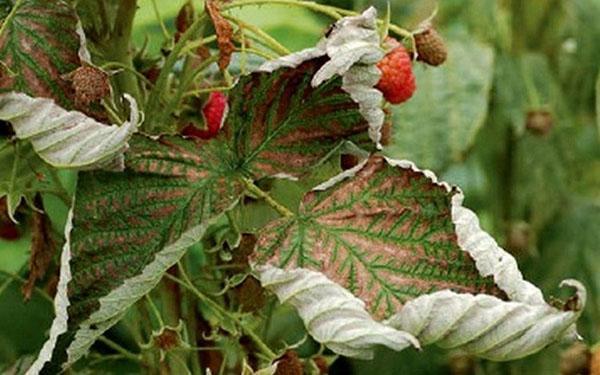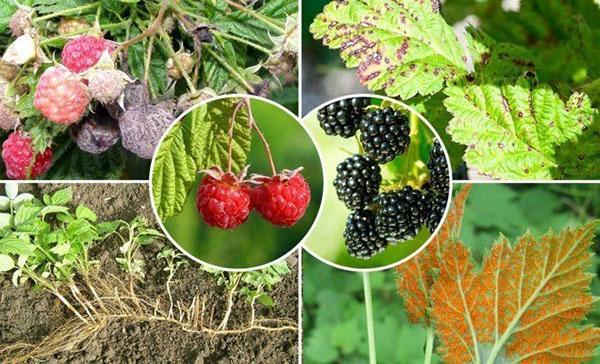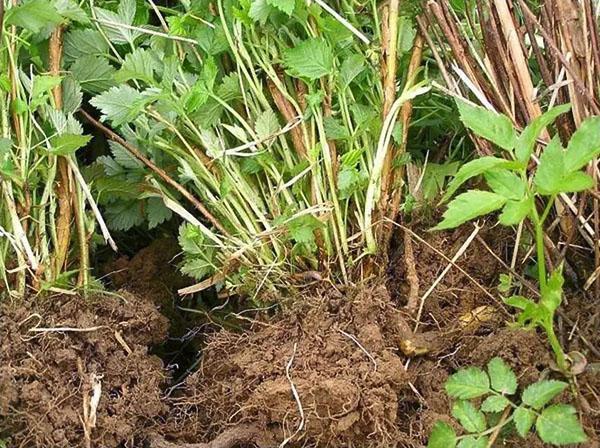Dangerous diseases of raspberries: description, photo, prevention
 Who doesn't love to feast on juicy berries picking them right from the bush? Unfortunately, all kinds of raspberry diseases infect the plant and deprive gardeners of this joy. To fully protect the culture from irreparable harm, it is extremely important to know your enemy by sight. Careful research by gardeners helps not only to recognize the first signs of shrub ailments, but also to take preventive actions to protect the plant. Let's try to understand the intricacies of this case in order to inflict a crushing blow on the hated enemy.
Who doesn't love to feast on juicy berries picking them right from the bush? Unfortunately, all kinds of raspberry diseases infect the plant and deprive gardeners of this joy. To fully protect the culture from irreparable harm, it is extremely important to know your enemy by sight. Careful research by gardeners helps not only to recognize the first signs of shrub ailments, but also to take preventive actions to protect the plant. Let's try to understand the intricacies of this case in order to inflict a crushing blow on the hated enemy.
Common raspberry diseases: signs of appearance and methods of control

Attention - witch's broom
 A complex viral disease occurs as a result of insect bites that suck the sap (aphids) from the shoots of the plant. Since they cannot be noticed immediately, the virus spreads throughout the culture, gradually destroying it. The visible manifestation of raspberry disease is the many shoots that grow from the root system of the culture. There may be more than 250 of them. They are usually much thinner than the rest, which is the first signal of infection.
A complex viral disease occurs as a result of insect bites that suck the sap (aphids) from the shoots of the plant. Since they cannot be noticed immediately, the virus spreads throughout the culture, gradually destroying it. The visible manifestation of raspberry disease is the many shoots that grow from the root system of the culture. There may be more than 250 of them. They are usually much thinner than the rest, which is the first signal of infection.
In addition, the shrub blooms later than usual. Buds form at the bottom of the stems. They do not have a pistil and stamens, but they are full of large petals, which often turn into leaf plates. If you do not take any action, the leaves on the bushes become smaller and the stems become shorter. As a result, low yields or no fruit at all.
The witch's raspberry broom disease depicted in the photo will help attentive summer residents quickly identify a malicious enemy and take appropriate measures:
- remove affected bushes from the garden;
- control the presence of insect pests;
- process the culture with chemicals.
To prevent contamination of healthy plants, the affected bushes are burned outside the garden. As you can see, it is quite simple to defeat the disease, the main thing is not to hesitate, be careful and waste precious time.
Often, infection occurs through the resulting wounds that the gardener can inflict on the culture.
Rust is a sign of slow death
 The causative agent of this disease of raspberries is considered to be fungal microorganisms that successfully multiply on the culture and feed on its juice. The defeat occurs gradually. In the spring, miniature yellow or orange pads appear on the front side of the leaf plates. Over time, they spread to the shoots of the culture. In the middle of summer, the fungus infects the foliage from the back, where it hibernates after falling.
The causative agent of this disease of raspberries is considered to be fungal microorganisms that successfully multiply on the culture and feed on its juice. The defeat occurs gradually. In the spring, miniature yellow or orange pads appear on the front side of the leaf plates. Over time, they spread to the shoots of the culture. In the middle of summer, the fungus infects the foliage from the back, where it hibernates after falling.
Most often, the disease develops in conditions of high humidity. Therefore, it is during such periods that you should carefully observe the culture.
To know how to deal with rust on raspberries, you need to listen to seasoned gardeners who have a reliable weapon in their arsenal. First of all, you should not take lightly fallen leaves. It is in it that dangerous fungi hide for the winter. Therefore, regular autumn cleaning of the raspberry patch is an effective measure to combat rust. For the prevention of the disease, the culture is treated with special preparations. The procedure is performed during the growing season.
The invisible killer is chlorosis

Like any disease, chlorosis attacks raspberries in an invisible way. Only after some time do the first symptoms appear:
- reduction in the size of sheet plates;
- weak shoot growth;
- discoloration of foliage;
- nondescript fruits.
At first, the plate turns yellow along the main vein, gradually spreading over the entire area. In this form, the bush resembles autumn wilting. But the disease recedes only to the complete fall of the foliage. The shoots of the infected plant become slightly elongated. And if fruits appear, then they are often one-sided and unpleasant in taste.
Most often, infection occurs for the following reasons:
- grafting infected cuttings;
- simultaneous pruning sick and healthy bushes;
- sucking insects;
- close contact of plants in the same area.
Practice has shown that raspberry chlorosis cannot be treated. Therefore, the infected instances should be removed and, if possible, burned. To prevent infection, experts advise planting only healthy bushes on the site. Also, regular treatment of the culture with preparations from insect pests will not hurt.
Anthracnose: attack on succulent shoots
 The defeat of the culture begins with the appearance of single spots on the stems. They are often gray or whitish in color. Their edges are framed by a magenta line, so they seem pretty pretty. In fact, this is how raspberry anthracnose is manifested - an ominous disease of the plant. It causes the tissues that cover the stems to dry out. A little later, the bark falls off. As a result, the foliage begins to wither, and the plant loses its vitality. The disease develops after the appearance of leaf plates. Especially suitable conditions for infection are wet weather.
The defeat of the culture begins with the appearance of single spots on the stems. They are often gray or whitish in color. Their edges are framed by a magenta line, so they seem pretty pretty. In fact, this is how raspberry anthracnose is manifested - an ominous disease of the plant. It causes the tissues that cover the stems to dry out. A little later, the bark falls off. As a result, the foliage begins to wither, and the plant loses its vitality. The disease develops after the appearance of leaf plates. Especially suitable conditions for infection are wet weather.
To prevent anthracnose, it is advisable to remove fallen leaves from the garden every autumn. Try to regularly clear the raspberry thickets. Treat bushes with preparations that contain copper.
Didymella: a beautiful name with dangerous consequences
 The main causative agent of the disease is a fungus, the vitality of which is amazing. The microorganism reproduces especially actively in inclement weather. It affects not only the aerial parts of the culture, but also the rhizome. In the photo of raspberry didimella, the signs of the disease are clearly visible, which gradually kill it.
The main causative agent of the disease is a fungus, the vitality of which is amazing. The microorganism reproduces especially actively in inclement weather. It affects not only the aerial parts of the culture, but also the rhizome. In the photo of raspberry didimella, the signs of the disease are clearly visible, which gradually kill it.
 Purple spot (another name for the infection) often appears on young crop stems in early or mid-June. Its first signs are formed at the base of the rhizome in the form of purple-brown spots. Later, such "patterns" are observed at the points of contact of the leaf petioles with the shoot. With the active development of the disease, the spots diverge throughout the plant. As a result, the branches lose their elasticity and break arbitrarily. The buds practically do not develop, and the foliage is covered with brown spots.
Purple spot (another name for the infection) often appears on young crop stems in early or mid-June. Its first signs are formed at the base of the rhizome in the form of purple-brown spots. Later, such "patterns" are observed at the points of contact of the leaf petioles with the shoot. With the active development of the disease, the spots diverge throughout the plant. As a result, the branches lose their elasticity and break arbitrarily. The buds practically do not develop, and the foliage is covered with brown spots.
What can be done to save culture? How to cure raspberry purple spot and achieve success in the battle for life? There are several simple ways:
- in early spring, before bud break, raspberries are treated with urea (700 g of substance are taken per 10 liters of water);
- during flowering, the bushes are sprayed with a solution of the same urea (50 g of fertilizers are diluted with 10 liters of water);
- during the budding period, the plant is given a "shower" with Bordeaux liquid;
- after fruiting, raspberries are treated with ready-made chemicals (Topaz, Fundazol).
As you can see, advice on how to treat young raspberry shoots that wither is not at all difficult. The main thing is to adhere to the recommendations of specialists and properly prepare solutions for processing culture.
To increase the plant's resistance to purple spotting, it should be fertilized regularly with phosphate-potassium substances.
An exquisite mosaic on leaves that does not please the eye
 Raspberry pests and diseases are often dependent on each other. Therefore, the infection occurs during the vital activity of viruses carried by sucking insects. After the defeat of the culture, spots form on the leaf plates. They are arranged in a chaotic manner and are colored pale green or yellow. When the summer heat sets in, the spots gradually disappear. As soon as the coolness returns, symptoms begin to appear again.
Raspberry pests and diseases are often dependent on each other. Therefore, the infection occurs during the vital activity of viruses carried by sucking insects. After the defeat of the culture, spots form on the leaf plates. They are arranged in a chaotic manner and are colored pale green or yellow. When the summer heat sets in, the spots gradually disappear. As soon as the coolness returns, symptoms begin to appear again.
Observations show that mosaic leaf spot has a detrimental effect on the entire crop. Shoots become weak and thin. And small berries have practically no taste and are tough to the touch. The affected plant stops growing and becomes a dwarf bush. Over time, it dies.
A powerful blow "below the belt" - raspberry root cancer

Most often, the culture suffers from this disease. The infection penetrates the rhizome due to various mechanical damage:
- during landing;
- loosening the site;
- actions of rodents.
 When raspberries are affected root cancer, the underground part of the culture is overgrown with numerous hillocks. They are formed as a result of disturbances that occur inside bacteria. The infected plant slows down growth, and the leaves begin to turn yellow. It is interesting that the process of oppression of the bush lasts about 2-3 years. During this period, the growths on the roots of raspberries are completely destroyed by microorganisms that live in the soil. As a rule, the plant "resurrects" and continues to bear fruit. In some cases, the disease returns.
When raspberries are affected root cancer, the underground part of the culture is overgrown with numerous hillocks. They are formed as a result of disturbances that occur inside bacteria. The infected plant slows down growth, and the leaves begin to turn yellow. It is interesting that the process of oppression of the bush lasts about 2-3 years. During this period, the growths on the roots of raspberries are completely destroyed by microorganisms that live in the soil. As a rule, the plant "resurrects" and continues to bear fruit. In some cases, the disease returns.
 Having become better acquainted with raspberry diseases, it is much easier to protect the plant from irreparable harm. Identifying symptoms will help you respond to the problem in time. Routine treatment of a plant with chemicals often serves as a prophylactic agent against infections. Careful crop care makes it possible to harvest generous harvests of berries every year.
Having become better acquainted with raspberry diseases, it is much easier to protect the plant from irreparable harm. Identifying symptoms will help you respond to the problem in time. Routine treatment of a plant with chemicals often serves as a prophylactic agent against infections. Careful crop care makes it possible to harvest generous harvests of berries every year.